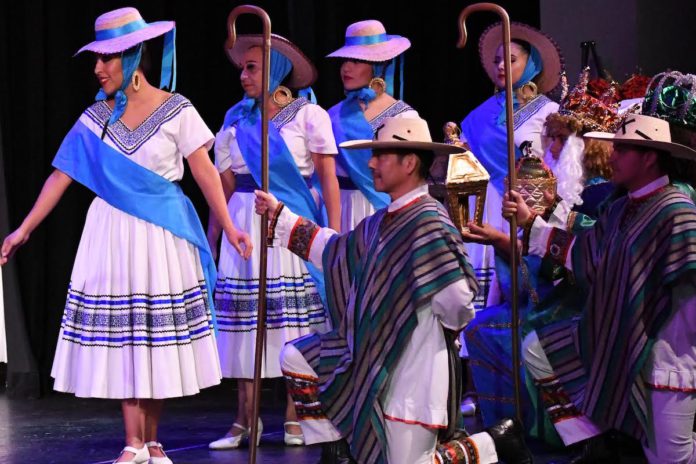“I’ve been doing this for over 50 years of my life,” said Carlos Moreno Jr., a professionally-trained dancer and now director of the Ballet Folklorico Mexicano de Carlos Moreno dance company that was founded by his father in 1967, “and every year I’m still being exposed to new dances.”
The group’s recent “Las Tortugas” dance from the Chiapas region of Mexico tells the story of “turtles that come on beaches and the women who protect them,” said Ariela Moreno, Carlos’s daughter. The high-school senior will perform in the company’s upcoming Christmas event. The choreography even included baby turtle props, a reference to sea turtles who return en masse every year to the same beaches to lay eggs and hatch new generations.
The Folklorico dancers in San Leandro have also returned year after year since 1971 to perform their beloved “Navidad en Mexico” show, each time featuring a new generation of children alongside the company’s professional group, and debuting new choreography along with traditional classics. This year, the two-hour extravaganza will occur on the weekend of Dec. 14-15.
“It’s always the highlight of my year. We only get to do some of these dances once a year at our Christmas Show.”
Ariela Moreno
“It’s a very beautiful, colorful production, and will keep you on your toes as to what comes next,” said Alexandra Flores-Mejia, who joined the Carlos Moreno group after graduating from James Logan High School in Union City over a decade ago. Flores-Mejia particularly enjoys the Calabaceados style of dance from the state of Baja California, which she says has “a lot of fast footwork, high kicks and high energy.”
Ballet Folklorico encompasses a stunning array of styles, as diverse as the country it hails from. Popularized in the 1950s and ’60s, the genre blends indigenous Mexican dance with elements of formal western technique. “It takes years to master,” explained Carlos Moreno Jr., who started dancing when he was a toddler and accompanied his father as a teenager on research trips to different parts of Mexico, before joining Ballet Folklorico as a professional dancer in Mexico City. Since then, Moreno has returned to the Bay Area and continued building out the organization here.
A common perception of Mexican dance includes women with flowing skirts accompanied by men with wide hats and a mariachi band—a style popularized in Guadalajara, a long-time tourist destination since the colonial era. But the country has many other traditions spanning its mountainous and coastal regions. Folklorico is not “just a bunch of people hopping around a hat, a ‘sombrero,’” Moreno said, but a real dance form that artists can take pride in learning and developing seriously.
Some locales favor sandals or dancing barefoot, while others might feature simple peasant garb. To reflect these different cultures authentically, the studio in San Leandro maintains a rich variety of costumes, some of which were handmade by Moreno’s mother decades ago, and others which were specially sourced from Mexico. The company has also started selling its own specialty outfits, which, to Moreno’s delight, have been shipped to customers globally as Folklorico Mexicano becomes more popular.
In the Bay Area, Carlos Moreno’s dancers have performed at community events, school shows, and even San Jose Sharks and San Francisco 49ers games. Luna Garcia, an instructor and dancer with the company, said it feels invigorating to see so much cultural acceptance and representation. “When I was younger, I never saw this type of celebration for different cultures,” Garcia said, adding, “Now that I’m older and going to the elementary schools to perform, I’m able to see that they care a lot about celebrating and respecting other cultures. I love that.”
Of all the Folklorico Mexicano performances, the annual “Navidad en Mexico” show is particularly special. “It’s always the highlight of my year,” Ariela Moreno said, explaining, “We only get to do some of these dances once a year at our Christmas show.” Ariela, who intends to study dance in college following the footsteps of her father and grandfather, is particularly eager to see this year’s “Mariachi Viva” song, which her father choreographed. “I’ve done it since I was 11 years old, and it’s now my sister’s turn,” she said, laughing.
For dancers, Ballet Folklorico offers a chance to feel a larger sense of belonging and connection. From young to old, past to present, the form continues to expand in imaginative ways and embraces a spirit of celebration that remains relevant today. Mejia-Flores notes the inspiring example of her former high school dance teacher, who is still part of the Folklorico company past the age of seventy. “As long as my body is letting me, I don’t see myself stopping,” she said.
Echoing her fellow dancer’s feelings, Ariela Moreno also reflected on the powerful cultural tradition she is part of. “Folklorico dance is the dance of the people, and it derives from the stories and legends that are told in Mexico,” she said. “For us Folklorico dancers, it’s not just a way to express ourselves, but to express our culture.”
“Dance is like my way of life. I don’t think I would be able to live without it,” Ariela concluded. Many dancers, across cultures, would agree with this sentiment.
Navidad en Mexico
Saturday, Dec. 14: 7pm
Sunday, Dec. 15: 2pm
San Leandro Performing Arts Center
2250 Bancroft Ave., San Leandro
balletfolkloricomexicano.org
Tickets on Eventbrite
Early bird price: $35 by Nov. 30
Regular price: $50 purchased after Dec. 1




